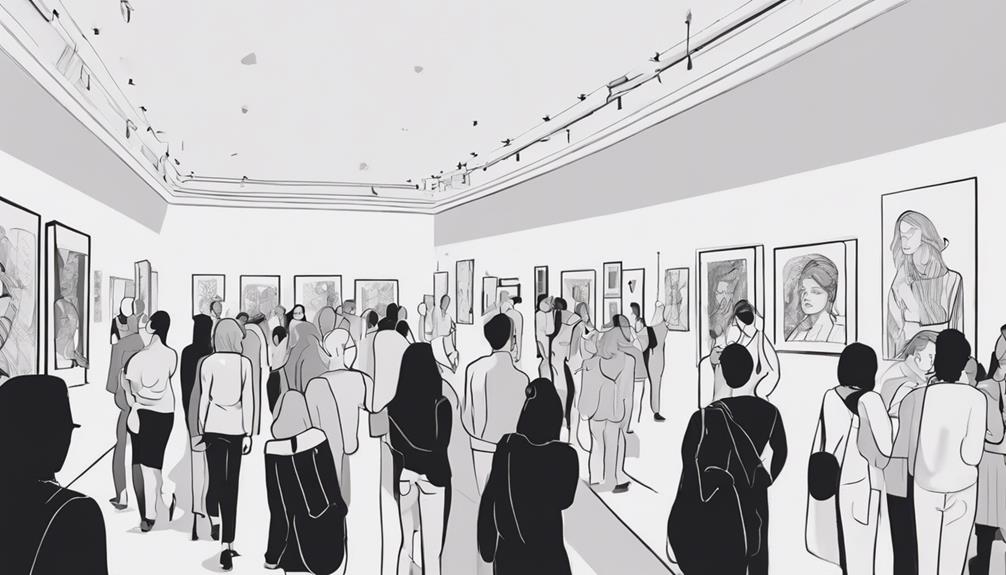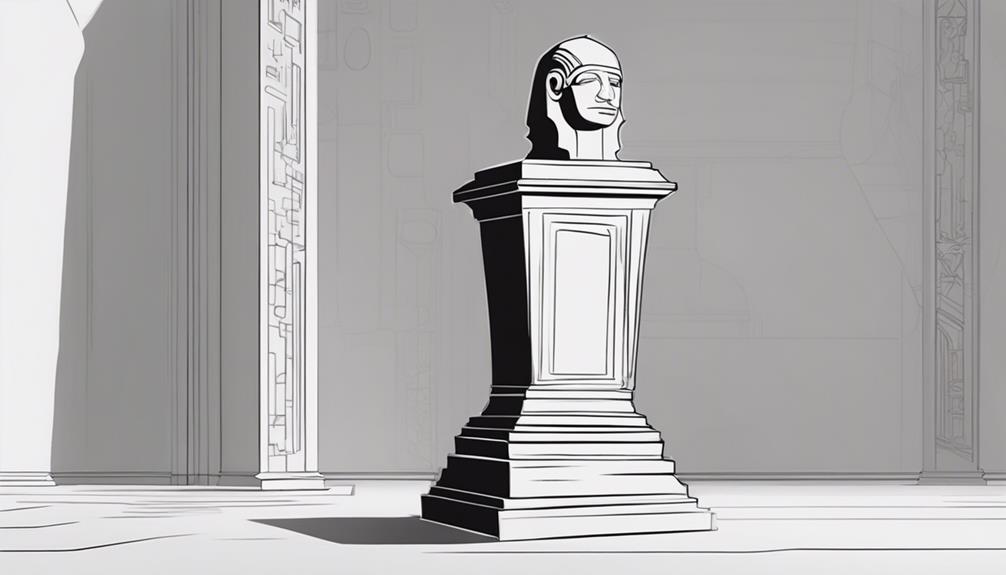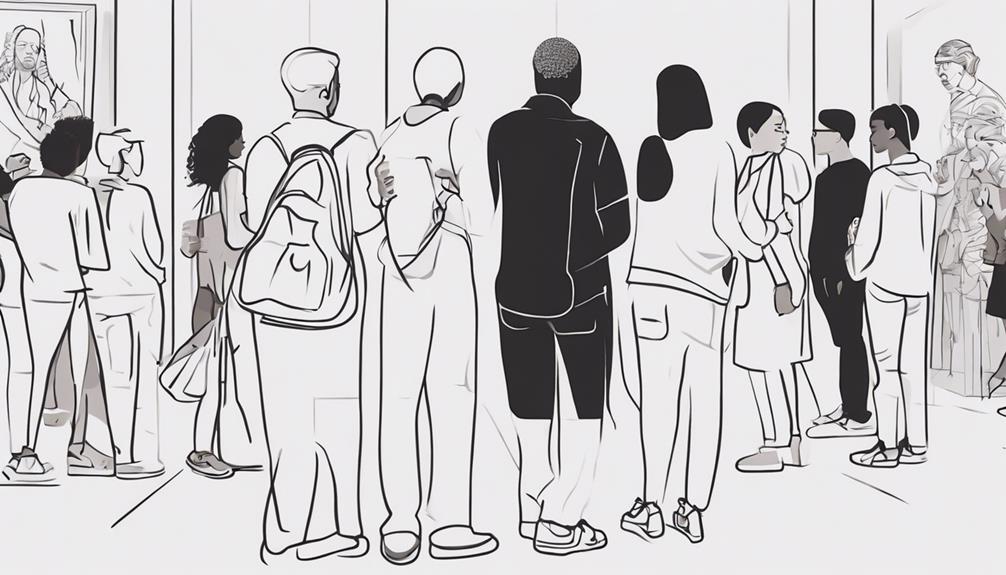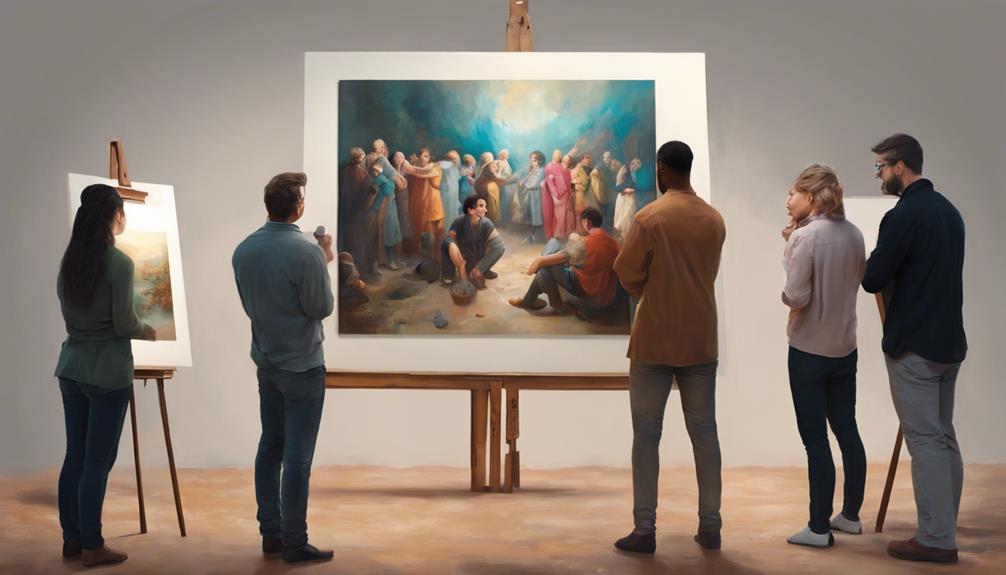Art valuation is a complex interplay of various factors that contribute to the perceived worth of a piece of art. From objective measures like quality and condition to more subjective elements such as an artist's reputation and the cultural impact of the artwork, the determination of art's value is a multifaceted process. Understanding how these different factors converge to assign a value to art not only sheds light on the dynamics of the art market but also raises intriguing questions about the intrinsic nature of artistic worth.
Key Takeaways
- Emotional responses, cultural influences, and artist reputation shape art's value.
- Market demand, historical significance, and provenance impact artwork's objective worth.
- Artist's reputation drives pricing; market trends and demand influence art value.
- Historical context, societal significance, and condition affect the value of art pieces.
Subjective Factors in Art Valuation

Subjective factors play a crucial role in the valuation of art, encompassing emotional responses, personal connections, and cultural influences that shape individuals' perceptions and assessments of artworks. The subjective value of art is not solely determined by its physical attributes but also by the emotional impact it has on viewers. Emotional responses to art can significantly affect its perceived value, as individuals may assign personal significance based on their experiences, memories, and feelings evoked by the artwork. Furthermore, an individual's cultural background plays a pivotal role in shaping their understanding and appreciation of art. Cultural influences can influence the way in which art is interpreted, valued, and integrated into one's identity. Different societies and individuals may ascribe varying levels of value to art based on their cultural norms, beliefs, and traditions. Thus, subjective factors such as emotional responses and cultural background are integral in determining the subjective value of art, highlighting the diverse perspectives and interpretations that contribute to the complexity of art valuation.
Objective Measures of Art Worth
Objectively assessing the worth of art involves considering various quantifiable factors such as the artist's reputation, artwork's condition, provenance, market demand, and artistic significance.
- Artist's Reputation: The standing of an artist in the art world significantly impacts the objective value of their work.
- Artwork's Condition: The state of preservation and any restoration done on an artwork can influence its value.
- Provenance: The documented history of ownership can add value to art pieces.
- Market Demand: The level of interest and desire for a particular artist or style affects the objective value of art.
- Artistic Significance: The historical and cultural importance of an artwork can contribute to its objective worth.
Analyzing these objective measures, along with factors like scarcity and expert assessments, provides a more structured approach to determining the value of art. The interplay of these elements showcases the complexity of valuing art based on tangible criteria rather than purely subjective opinions.
Influence of Artistic Reputation

The influence of an artist's reputation on the perceived value of their artwork in the art market is a critical factor that dictates pricing and market demand. Established artists with strong reputations, such as Niki de Saint Phalle and Andy Warhol, often command high prices due to their renowned status. The visibility and recognition an artist garners within the art world significantly impact the perceived value of their work. Additionally, a visible signature on an artwork can substantially increase its value by enhancing the artist's provenance and reputation. High-net-worth collectors play a vital role in influencing an artist's value by paying premiums for pieces, thereby elevating the artist's stature in the art market.
| Factors Influencing Artist's Reputation | ||
|---|---|---|
| Visibility within Art World | Enhanced Provenance | Impact on Collectors |
| Recognition in Art Market | Visible Signature | High-net-worth Collectors' Influence |
Market Trends and Demand
Analyzing recent market trends and demand in the art industry reveals significant shifts driven by high-net-worth collectors' increasing investments in NFTs. This changing landscape has implications for various aspects of the art market, including:
- Art Fairs: Art fairs continue to be essential in driving sales and connecting collectors with artists and galleries.
- Auctions: Auction houses play a crucial role in setting benchmarks for art prices and influencing market trends.
- Market Trends: The art market is dynamic, with trends shifting based on factors like collector preferences and global economic conditions.
- Demand: Understanding the demand for different types of art is key in determining their value and market trajectory.
- Online Art Platforms: The rise of online platforms has revolutionized how art is bought and sold, making it more accessible to a global audience and impacting market dynamics.
These factors collectively shape the current state of the art market, reflecting the evolving preferences and behaviors of collectors and investors.
Historical Significance in Valuing Art

The historical significance of art is intricately linked to the impact of events, cultural relevance, and the influence of the artist. Understanding how these factors intersect can provide valuable insights into the value of a piece within the art market. By analyzing the context in which an artwork was created and the role it played in shaping cultural narratives, one can better appreciate its historical significance and monetary worth.
Impact of Events
With a keen eye on historical events, the valuation of art transcends mere aesthetic appreciation to encompass the cultural and societal significance embedded within each artistic creation. Historical events like wars, revolutions, and cultural movements can significantly impact the value of art. Artworks created during historically significant periods may hold higher value due to their connection to important events. The provenance and historical context of an artwork can enhance its value by associating it with notable events or figures. Collectors often seek out art from specific historical periods, driving up demand and consequently increasing the value of such pieces. Artworks linked to iconic historical moments or figures can command premium prices at auctions due to their cultural significance and rarity.
Cultural Relevance
Cultural relevance in the valuation of art is intricately tied to its historical significance, shaping the perception and value of artistic creations within society. Artworks that resonate with important historical events or cultural movements often command a higher value due to their significance and influence on societal narratives. The connection of art to cultural heritage enhances its importance in the art world, with collectors and institutions prioritizing culturally relevant pieces for preservation and exhibition. Such artworks not only hold monetary value but also serve as reflections of collective identity and memory. In the competitive art market, pieces that strike a chord on a cultural level tend to attract attention, leading to increased prices and recognition, highlighting the enduring impact of cultural relevance on the valuation of art.
Artist Influence
Examining artists' influence through their historical significance is paramount in evaluating the value of art within the art market and cultural discourse. The following points highlight the importance of artist influence in determining the value of art:
- The historical significance of an artist is a key factor in assessing the worth of their artwork.
- Artists like Monet and Picasso, who have made substantial impacts on art history, often fetch higher prices for their pieces.
- Renowned figures such as Van Gogh and Da Vinci have solidified their position as valuable artists in the art market.
- Artworks by artists who have significantly contributed to art movements are highly coveted and valued.
- An artist's historical significance can significantly enhance the value and desirability of their creations in the art world.
Cultural and Societal Impact

Art holds immense power in shaping perceptions and reflecting societal values through its diverse forms and expressions. By influencing how individuals view the world and portraying cultural narratives, art plays a pivotal role in shaping collective identities and fostering a sense of community. The impact of art on society extends beyond aesthetics, serving as a mirror to societal norms, beliefs, and experiences.
Influence on Perceptions
The influence of cultural and societal impact on perceptions of art is profound, shaping interpretations and values through shared stories and human conditions.
- Personal experiences and cultural backgrounds contribute to the perceived value of art.
- Art communicates ideas, values, and emotions, reflecting societal meanings and fostering communal experiences.
- The social value of art lies in its ability to share stories and cultural elements, resonating with viewers on a deeper level.
- Art's value extends beyond financial worth, encompassing its role in communicating and reflecting societal values and human experiences.
- The interplay of cultural and societal influences enriches the understanding and appreciation of art, highlighting its significance in reflecting the human experience.
Reflects Societal Values
Reflecting societal values, art serves as a mirror that captures and communicates the ideas, emotions, and cultural significance prevalent within a given society. Artworks value is deeply intertwined with the societal and cultural impact they hold, influencing how they are perceived and valued. The artists exhibition history can also play a significant role, as their reputation and past works can affect the perceived value of their current pieces. Supply and demand dynamics in the art market further contribute to determining the commercial value of artworks, with scarcity often driving up prices. Additionally, the materials used in creating art can impact its value, with certain mediums or techniques being more sought after than others. A concise table to illustrate these points:
| Keywords | Impact on Art Value |
|---|---|
| Artworks value | Influenced by societal and cultural significance |
| Artists exhibition history | Reputation and past works affect perceived value |
| Supply and demand | Scarcity can drive up prices |
Evaluating Artistic Innovation
In the realm of art evaluation, the assessment of artistic innovation plays a pivotal role in determining the significance and market value of creative works. Artistic innovation can greatly influence how a piece of art is perceived and valued in the art world. Here are five key points to consider when evaluating artistic innovation:
- Innovative Techniques: Artists who experiment with new techniques, materials, or concepts often produce work that stands out and garners attention.
- Desirability: Art that showcases originality and innovation tends to be more sought after by collectors and art enthusiasts.
- Groundbreaking: Works that introduce groundbreaking ideas or approaches can have a lasting impact on the art world and command higher prices.
- Forward-Thinking: Artists who demonstrate a forward-thinking mindset by challenging conventions and pushing boundaries are often celebrated for their innovation.
- Artistic Innovation: The ability of an artist to bring fresh perspectives and creativity to their work is a key factor in assessing the artistic innovation of a piece.
Frequently Asked Questions
What Defines the Value of Art?
Cultural significance and market demand, artist reputation and uniqueness, medium used and size of artwork, condition of piece and provenance, artistic skill, and emotional impact all contribute to defining the value of art. These factors collectively shape the perceived worth of a piece, reflecting a complex interplay between subjective and objective elements in the art world. Understanding these determinants provides insight into the intricate process of valuing artistic creations.
What Factors Determine the Value of a Work of Art?
Cultural significance and market demand play pivotal roles in determining the value of a work of art. Artistic technique, historical context, emotional impact, rarity, material quality, provenance, subject matter, and artist reputation collectively shape the perceived worth of a piece. These elements interact dynamically, creating a complex tapestry that influences both the intrinsic and market value of artwork. Understanding these multifaceted factors is essential in comprehending the diverse determinants of art's value.
Who Determines the Value of a Piece of Art?
Art critics, collectors, auction houses, galleries, and market demand collectively influence the determination of a piece of art's value. Factors such as scarcity, artist reputation, provenance, subjective perception, and cultural trends play a critical role in this evaluation. The interplay of these elements, guided by expertise and market forces, ultimately shapes the perceived value of art within the art world and among potential buyers.
How Do We Determine the Value of Works of Art?
Determining the value of works of art involves a multifaceted approach encompassing cultural significance, market demand, artist reputation, uniqueness, art medium, historical context, aesthetic appeal, craftsmanship, and investment potential within the art market trends. These factors collectively influence the valuation process, reflecting the dynamic interplay between subjective and objective considerations in the art world. Understanding these intricacies is crucial for comprehending the complexities of art valuation and the broader art market landscape.
Conclusion
In the intricate tapestry of the art world, the value of art is woven together by a complex interplay of subjective and objective factors. From artistic quality to market trends, from historical significance to cultural impact, each thread contributes to the overall worth of a piece. Just as a skilled artist combines various elements to create a masterpiece, the valuation of art requires a discerning eye to appreciate the layers of meaning and significance embedded within each creation.
